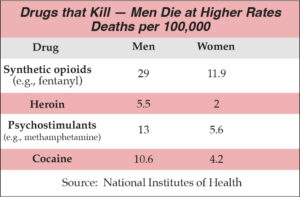By Deborah Jeanne Sergeant
 Men died of opioid and stimulant drugs at a rate two to three times higher than women between 2020 and 2021, according to a recent study. The data looked at fentanyl, heroin, methamphetamine and cocaine.
Men died of opioid and stimulant drugs at a rate two to three times higher than women between 2020 and 2021, according to a recent study. The data looked at fentanyl, heroin, methamphetamine and cocaine.
The study said that men’s higher rates of use do not entirely account for the increase in mortality risk.
The study was published by Neuropsychopharmacology and led by investigators at the Icahn School of Medicine at Mount Sinai in New York City and the National Institute on Drug Abuse, part of the National Institutes of Health.
“Though men and women are being exposed to the modern, fentanyl-contaminated drug supply, something is leading men to die at significantly higher rates,” said Nora Volkow, physician and director of NIDA and one of the co-authors on the study in a press release. “It may be that men use drugs more frequently or in greater doses, which could increase their risk of death, or there may be protective factors among women that reduce their risk of death compared to men.”
The study indicated that further research must be done to determine why more men die from stimulant and opioid overdoses than women.
“I am in agreement with the statistics, with which is hard to argue, as it’s consistent with what we see at the hospital and with emergency services calls,” said physician Gregory Serfer, medical director of Tully Hill Treatment & Recovery in Tully. “As for the reason, the study said that higher rate of use still does not account for the higher rate of death and that it could be based on biologics and gender-based differences.”
He hypothesizes that it’s likely not biological, but socially constructed beliefs about gender forming the driving differences that result in higher overdose rates. Men are generally more eager than women to take risks, especially when goaded by other men.
“The amount of use is a big influence,” Serfer said. “My experience shows men use significantly more than women. Men are less aware that they’re using significantly more than women. Women are more accurate reporters of amount of use. Men consistently underreport at a greater rate than women do. They say they use less and with less frequency and report less actual amount ingested.
“Women afraid to lose children: That’s a possible factor. Women still tend to come across as more nurturing and less selfish in a lot of ways than men, especially when it comes to their children. [Maternal instinct] is an inborn trait with biological and societal influences. I think that plays a role.”
The source of the drugs can also make a difference. Serfer said that instead of prescription opioids, men tend to take more street drugs, which could be laced with fentanyl and other unknown substances. Women abusing substances tend to take prescription opioids, which are untainted and have a known dosage.
“I have seen this in my personal experience,” Serfer said. “But even if you look at it regardless of substance, men still overdose more than double compared with women.”
Evan Frost, assistant director of communications & public information at the NYS Office of Addiction Services and Supports in Albany, said that more than 70% of treatment admissions are male.
“A higher prevalence of substance use disorder in men is not new and has been a steady trend in both New York state and the rest of the country for years,” he said.
As to why more men are dying — especially since they’re entering treatment programs at higher rates — it’s not entirely clear.
Most of the programs OASAS offers are oriented towards men or are men-only, including programs on parenting, relationships in early recovery, anger management and specialized services for those involved in the criminal justice system.
“In general, we are also addressing opioid overdoses by increasing access to care through low threshold access to medications for opioid use disorder, providing overdose prevention education and naloxone and providing fentanyl and xylazine test strips so people who use drugs can be informed about what is in their supply,” Frost added.

